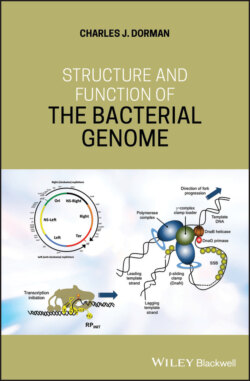Читать книгу Structure and Function of the Bacterial Genome - Charles J. Dorman - Страница 13
1.2 The Bacterial Chromosome
ОглавлениеE. coli K‐12 has played a central role in the history of bacterial genetics and bacterial physiology. The original K‐12 isolate came from a stool sample from a human patient suffering from diphtheria and was cultured in Palo Alto, California, USA, in 1922 (Bachmann 1996). This isolate was the ancestor of W1485 from the Joshua Lederberg laboratory, the isolate that was named MG1655 by Mark Guyer (hence ‘MG’). The first E. coli chromosome to be sequenced came from this intensively studied MG1655 strain (Blattner et al. 1997). However, this was not the first bacterial chromosome to have its complete nucleotide sequence determined: that honour belongs to Haemophilus influenza (Fleischmann et al. 1995).
The Blattner lab chose MG1655 because it has undergone relatively little genetic manipulation and is considered a good representative of wild‐type E. coli. It has been cured of bacteriophage lambda and of the F plasmid and has few genetic lesions. An ilvG mutation deprives it of acetohydroxy acid synthase II, making it prone to valine‐dependent isoleucine starvation (Lawther et al. 1981, 1982) and there is an IS5 insertion in the rfb locus that interferes with O‐antigen synthesis (Liu and Reeves 1994). If this mutation is repaired, the bacterium has its lipopolysaccharide expression reinstated and it becomes pathogenic in an infection model based on the worm Caenorhabditis elegans (Browning et al. 2013). Strain MG1655 displays mild starvation for pyrimidine arising from poor expression of its pyrE gene: the cause is a frameshift mutation at the end of the rph locus (rph‐1) (Jensen 1993). Interestingly, genome sequence analysis shows that MG1655 is closely related to NCTC 86, the bacterium originally named Bacillus coli by Theodor Escherich in 1885, isolated before the antibiotic era (Dunne et al. 2017).
The E. coli K‐12 chromosome is a single, covalently closed, circular, double‐stranded DNA molecule of 4 639 221 bp (Blattner et al. 1997). Although chromosome circularity is the norm in E. coli, cells in which the chromosome is artificially linearised (with the ends closed by hairpin turns) are viable, show few alterations in gene expression, have normal nucleoid structure, and do not display growth defects (Cui et al. 2007). Thus, the circular nature of the chromosome is not essential for its functionality or for its ability to be replicated and to be segregated at cell division.
The E. coli chromosome was visualised originally in the early 1960s by autoradiography of cells fed with tritiated thymidine in a classic experiment that also revealed the existence of the moving replication fork (Cairns 1963a,b). The chromosome undergoes bi‐directional replication from its oriC locus (Kaguni 2011), creating two replichores: Left and Right (Figure 1.1) (Lesterlin et al. 2005; Wang, X., et al. 2006). Through a process of semi‐conservative DNA replication, the bacterium acquires a second copy of its chromosome prior to cell division. In rapidly growing bacteria, one or more additional rounds of chromosome replication are initiated before the first one is completed, creating multiple copies of those chromosomal sequences that lie closest to oriC (Figure 1.1) (Cooper and Helmstetter 1968). Genes in the oriC‐proximal zones of the E. coli chromosome will be present in higher copy numbers than genes in Ter, the region of the chromosome where replication terminates. In slower‐growing bacterial populations, gene copy numbers are more in balance around the chromosome with only a twofold difference in copy number between genes close to oriC and those near Ter.
Figure 1.1 The macrodomain structure of the E. coli chromosome. Shaded segments represent the Ori, Right, Ter, and Left macrodomains, and the Left and Right non‐structured regions. The curved arrows outside the circular chromosome represent the Left (anticlockwise) and Right (clockwise) replichores. (a) The positions of genes that encode NAPs, chromosome organisation factors, topoisomerases, proteins involved in the process of transcription, the Hfq RNA chaperone are indicated around the periphery of the chromosome. (b) The positions of the seven rrn operons and genes encoding transcription regulators that are discussed in the text are shown. The positions of the lac operon and the bacteriophage lambda attachment site (attλ) are also indicated.
Most of our knowledge about chromosome replication and segregation comes from studying a handful of model organisms: E. coli, Caulobacter crescentus, Vibrio cholerae, and Bacillus subtilis. The focus in this chapter will be on E. coli, with comparisons to other organisms where this is useful.
